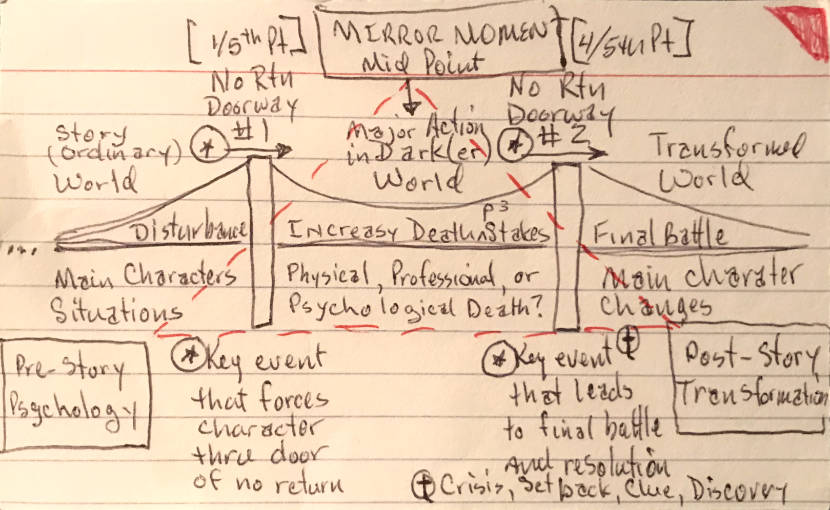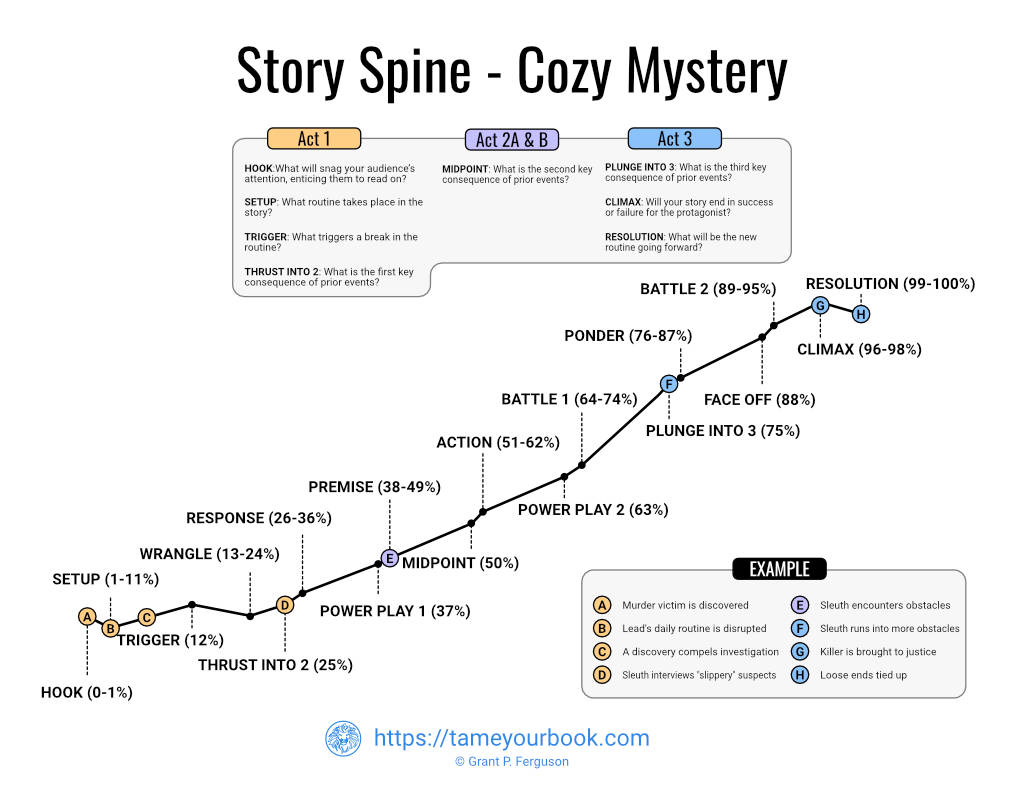My dilemma: I had the perfect book idea but lacked the story’s structure. My solution arrived when genre and story beats had a baby named Story Arc.
Table of Contents
Story Arc’s Birth
When your muse drops a big idea in your lap, it’s like the birth of a child. You want to nurture the newborn to maturity, but story ideas mirror life’s journey, and as we all know, that’s seldom a straight line from point A to B.
Your potential bestseller might come disguised as an opening line. Maybe it arrives as the spine chilling climax of a thriller. Other times, it’s a seed to nurture until it bears fruit.
And that’s the challenge. You never know what the future holds unless you map out the story arc trajectory.
Life Before Story Arc
Full of confidence that springs from ignorance, I wrote like a man on fire. I drafted scene after scene but did not know where the story would take me and my yet undefined audience. It’s embarrassing to admit, but back then, I spoke in my writer’s critique group as if I knew my story would be a bestseller.
I was in love with an unqualified story idea. Clueless, I shutdown helpful suggestions from others.
Armed with my false confidence, I talked and acted like a man on a mission until…
The Moment Doubt Knocked on My Door!
Doubt pounded on my brain’s front door with gut wrenching questions.
- Who would want to read my story?
- What content would readers expect?
- Did the audience care how the story was told?
- Would my characters convey the emotions readers craved?
- Were the story events sufficient to engage the audience?
- Would the suspense entice readers to keep turning pages?
- Why would my story matter to others?
When a Fact Overrode My False Confidence
Doubt got my attention, but a fact overrode my false confidence.
Blustering did not change a simple fact: I did not know how to structure a story, let alone pace the narrative. How was I to put it all together?
After studying books by gifted writing teachers, like James Scott Bell’s Super Structure* ** plus his Plot & Structure**, my awareness of story beats grew.
Drawn years ago, here’s my story structure index card.

*Note: Within Bell’s Super Structure, he mentioned “story arc” one time, but because I’m a visual learner, I needed an image. The card you see above was my first attempt so I could better understand a story arc. In hindsight, the need to know how to master story structure was converting me from a pantser to a plotter.
A Story Arc Based on Story Beats
Later, I reread Super Structure and Plot & Structure, and then used my increased understanding to create a generic story arc based on the story beats described by Bell.

I knew something was missing, so I kept studying story structure. That meant wading through information swamps. As my circle of trusted writing teachers grew, so did my understanding.
However, my gut told me something was still missing.
The Marriage of Genre and Story Beats
As writing insights wet my sponge (aka brain), I absorbed more theories while studying the tricky part of applying what I had learned.
I narrowed the field of focus to my reading interests: mysteries and thrillers. Huzzah!
Studying those genres generated hundreds of writing notes. Some clarified while others muddled my mind.
The concepts of story premise combined with story spine helped me understand how genre and beats influenced the story arc. It wasn’t one of those epiphanies where angels sang, but a clear call to apply what I had learned.
Conventions and Key Scenes
A Cozy Mystery shares patterns with a traditional Murder Mystery, but at some point, they differ. Understanding the shared traits and specific differences put me on the path to satisfying the target audience’s expectations.
For example, on Amazon Prime Video’s BritBox channel, you can watch episodes of Sister Boniface Mysteries and Death in Paradise. The first qualifies as a Cozy Mystery and the latter more of a Detective Mystery, but as shown in the example below, both share identical Story Spine beats.

Comparing Subgenres
In contrast to a Cozy Mystery, episodes of Peacock’s Law & Order: Organized Crime emphasize darker elements of yet another subgenre.
Given the differences, it’s important to understand your subgenre’s common and unique conventions and key scenes. Equally important, develop a keen awareness of your target audience’s preference for one versus another.
No One Has a Monopoly on Definitions
To maintain my sanity, I developed a version of global and scene beats, embedding the definitions into my Scrivener writing app. The custom scene template keeps those definitions at my fingertips while I write.
Here’s my short-hand version of each story beat for acts 1 through 3.
First Act: Stable World
- HOOK**: The scene introduces essential aspects of the story and grabs readers with an intense need to know what happens next.
- SETUP**: This sequence of scenes in the stable world establishes the characters, their wants, the stakes, the story’s theme, and the need for change.
- TRIGGER: In Act 1, a major event triggers the disruption of the protagonist’s stable world, stopping the hero from continuing as before.
- WRANGLE: In this sequence of scenes, the hero wrangles with the move-forward choices, but resists the need for change. As the protagonist debates the situation with self and others, this scene leverages the doubt and resistance established in the TRIGGER scene.
- THRUST INTO 2: In this scene, the hero acts on the choices made in the WRANGLE sequence, thrusting him into an unstable world.
**Note: The HOOK is actually part of the SETUP sequence of scenes, and to be clear, the HOOK can fall anywhere within that sequence based on the genre/subgenre and author’s preference.
Second Act (Part A): Unstable World
- RESPONSE: In this sequence of scenes, the hero responds to the unstable world, and meets who will help him or her learn the theme.
- POWER PLAY 1: This scene shows the antagonist’s power, provides clues, and establishes the core conflict.
- PREMISE: This sequence of scenes fulfills the novel’s premise, giving readers the events and emotions they crave.
- MIDPOINT: This scene shows the hero’s status (i.e., winning or losing), increases the stakes, and gives the protagonist insight, shifting the focus from want to need.
Second Act (Part B): Unstable World
- ACTION: In this sequence of scenes, the hero takes action based on discovery, changing hero’s trajectory (i.e., up or down).
- POWER PLAY 2: This scene hints at what is coming when the hero PLUNGES INTO 3, emphasizing the ever-increasing stakes.
- BATTLE 1: In this sequence of scenes, the hero fights the primary antagonist, and appears to win BATTLE 1.
Third Act: Changed World
- PLUNGE INTO 3: In this scene, the victory at the end of Act 2 is reversed, plunging the hero into an all-is-lost state (i.e., a looming sense of physical, professional, or psychological death). It’s the hero’s lowest point in the story.
- PONDER: In this sequence of scenes, the hero ponders prior choices, goal dedication, self worth, and personal abilities.
- FACE-OFF: The scene includes a face-off between hero and villain, brought on by the hero’s prior choices.
- BATTLE 2 : In this sequence of scenes, the hero and bad guy fight intensely, knowing only one will survive the second battle.
- CLIMAX: The scene concludes with hero achieving positive or negative results tied to both Story Goal and Need: win/win, win/lose, lose/win, or lose/lose.
- RESOLUTION: The last scenes tie up loose ends and satisfy readers with the emotions they expect from the Changed World, and can include an epilogue.
Creating a Story Arc Today
My reading preferences fall within the Mystery, Thriller, & Suspense category on Amazon, which ranks in popularity and revenue second only to the Romance category.
I love puzzles, so I’ve narrowed my recent writing and research primarily to the Cozy Mystery sub-subgenre.
💡 As of March 2022, a whopping 56% of the top 100 Cozies Mysteries were written as series — a bonus if you want to keep using your research and character development to produce more books in less time!
Genre Variations
Cozy Mystery content and writing styles range from silly (slapstick) to serious (darker with hints of noir and thrillers). Some writers follow the traditional path blazed by the likes of Dorothy L. Sayers and Agatha Christie while recent authors have brought new insights to this sub-subgenre.
For those who discount Cozy Mystery authors, fire up your copy of Publisher Rocket to see examples of the many writers who have achieved enviable revenue streams with their self-published ebooks and paperbacks.
The Big Reveal
The majority of today’s Cozies share core conventions and key scenes. I encourage you to take a deep dive into your favorite genre and discover the story nuances your readers seek.
Story Arc Example
Click here or on the image below to download an 8.5″ x 11″ PDF of the Cozy Mystery story arc.

Principles, Not Rules
Did you notice on the story arc how there are wide spans between key scenes where writers can use their creativity to write unique stories with diverse characters?
💡Genre conventions and key scenes are principles, enabling you to satisfy audience expectations in a profitable niche without feeling hemmed in by rules.
Conclusion
With a bit of study, you can create a story arc based on your favorite genre and story beats.
I hope last week’s post about genres combined with my Story Arc example will help shorten your writing journey!
Related Posts
- The Trellis Method: How Busy Writers Can Use Story Structure and Write a Book Readers Will Love
- Self-edit Your Novel (Part 3)
- How to Use Global Story Beats with Scrivener
- Exploring How to Structure a Book
- A Story Beats HOOK Example
- Story Beats: Discover an Easy Way to Write Your Novel’s Essential Scenes
- Story Structure: Exploring the Lester Dent Story Formula
- Story Structure: Erle Stanley Gardner’s Fiction Factory
Resources
Leave a Reply
What does your story arc look like based on your chosen genre and beats?
*As an Amazon Associate, I may earn a small commission from qualifying purchases, but it won’t cost you a penny more. Learn more in my Affiliate Disclaimer.


5 responses to “If I Was Creating a Story Arc Today”
Very interesting, Grant. Thanks for breaking this down into manageable chunks.
You’re welcome, Jacqui. Next week’s post will show how writers can use the expertise of other writers to fill out their genre profiles and story arcs.
I like that. I do lean on fellow authors at times!
This was awesome! In fact, I am writing a cozy right now. It’s for my writing group, a contest. Normally I’m a horror writer, so it’s all new to me!
Fantastic, Priscilla! Because of the wide Cozy styles range, your horror writing skills can kick into high gear. For example, the paranormal trope has interesting bits of horror without explicit violence or gore. Regardless of trope, over 75% of the covers are illustrated instead of images. If you’re interested in cover ideas, let me know and I’ll dig into my database and share examples.